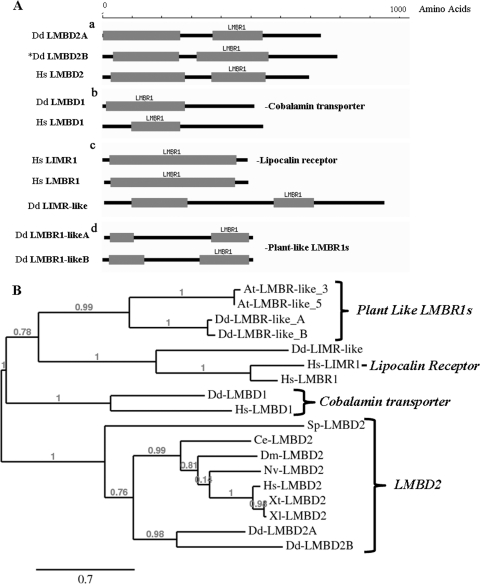Fig 2.
Domain structure and phylogenetic analysis of LMBR1 domain-containing proteins. (A) LMBR1 domain-containing proteins are displayed, with their LMBR1 domains represented by gray blocks. The scale shows the length in amino acids. (a) LMBR1-containing type 2 proteins (LMBD2): Dd-LMBD2A (sp|Q54Q92 D. discoideum), Dd-LMBD2B (sp|Q54TM2 D. discoideum), and Hs-LMBD2 (sp|Q68DH5 H. sapiens). (b) LMBR1-containing type 1 proteins that are probable cobalamin transporters: Dd-LMBD1 (sp|Q54KD1 D. discoideum) and Hs-LMBD1 (sp|Q9NUN5 H. sapiens). (c) The lipocalin 1 receptor: Hs-LIMR1 (sp|Q6UX01 H. sapiens) and the limb region 1 protein homologue, Hs-LMBR1 (sp|Q8WVP7 H. sapiens), as well as Dd-LIMR-like (XP_645368.1 D. discoideum). (d) The two plant-like LMBR1 proteins: Dd-LMBR1-likeA (sp|Q54BI3 D. discoideum) and Dd-LMBR1-likeB (sp|Q54QP7 D. discoideum) (34, 35, 36). (B) Phylogenetic analysis of LMBR1 domain-containing proteins across species using Muscle v3.7 on the phylogeny.fr platform. The phylogenetic tree was constructed using the maximum- likelihood method implemented in the PhyML program v3.0 aLRT and was drawn using TreeDyn v198.3 (12). Sequences utilized included the Dictyostelium and human protein sequences from panel A, as well as the protein sequences for Xt-LMBD2 (NP_001123692 X. tropicalis), Xl-LMBD2 (NP_001080584 X. laevis), Nv-LMBD2 (XP_001637236 N. vectensis), At-LMBR1-like 3 (sp|Q9SR93 Arabidopsis thaliana), At-LMBR1-like 5 (sp|Q9M028 A. thaliana), Dm-LMBD2 (gb|AAF54372 D. melanogaster), Ce-LMBD2 (NP_496413 C. elegans), and Sp-LMBD2 (NP_588183 S. pombe).

